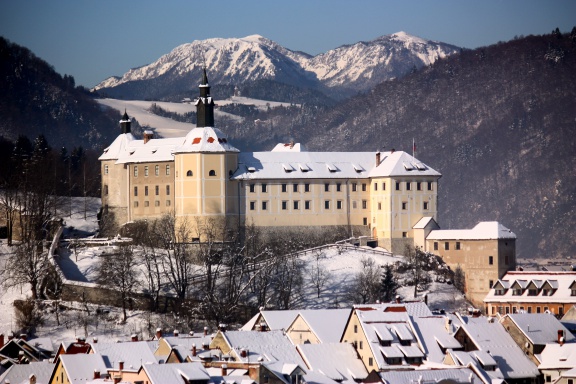Difference between revisions of "Loka Museum, Škofja Loka"
(imported from XML by extractor/importer) |
m (Text replace - "{{Abstract" to "{{Teaser") |
||
| Line 21: | Line 21: | ||
}} | }} | ||
| − | {{ | + | {{Teaser| |
In 1936 an exhibition on crafts and industry took place in Škofja Loka and soon after the local Museum Society was founded. The Society's goal was to collect as many works of art and antiques as possible in the town and its environs, and simultaneously to obtain suitable premises to exhibit these objects. In 1939 the museum collection was presented to the public in the premises of the town hall in Mestni trg and the Loka Museum was thus founded. After the war in 1946, Loka Museum was allocated its own premises in Puštal Castle, in which the collections were exhibited. In 1959 the museum moved to its present location in Loka Castle (first mentioned in 1215, although today's building dates from the 16th century). The collections were renovated several times and the last major changes were made in 1999. | In 1936 an exhibition on crafts and industry took place in Škofja Loka and soon after the local Museum Society was founded. The Society's goal was to collect as many works of art and antiques as possible in the town and its environs, and simultaneously to obtain suitable premises to exhibit these objects. In 1939 the museum collection was presented to the public in the premises of the town hall in Mestni trg and the Loka Museum was thus founded. After the war in 1946, Loka Museum was allocated its own premises in Puštal Castle, in which the collections were exhibited. In 1959 the museum moved to its present location in Loka Castle (first mentioned in 1215, although today's building dates from the 16th century). The collections were renovated several times and the last major changes were made in 1999. | ||
}} | }} | ||
Revision as of 16:01, 27 November 2009
-
23 Oct 2014
A lecture on the legacy of Bauhaus and Avgust Černigoj and their role in contemporary practices by Barbara Sterle Vurnik (Loka Museum, Škofja Loka) at the international symposium Bauhaus in the Life and Work of Selman Selmanagić
Major exhibitions include a collection of archaeological artefacts dating back to the Bronze Age; an important collection of medieval documents, which includes the donation deed of 973 from Emperor Oton II to Bishop Abraham which confirms that the Loka territory (the river basins of both Sora Rivers and the Sora Plain) belonged to the Bavarian Bishopric of Freising for no less than 830 years; the famous Škofja Loka Passion Play of 1721, Slovenia's oldest preserved drama text; two Renaissance inscription slabs from 1513, one of which, depicting the Škofja Loka coat-of-arms, bears witness to the reconstruction of the town after the earthquake; and a guilds collection which presents the heritage of the Loka guilds, the oldest being those of tailors, shoemakers, furriers and potters (deeds, small chests, jugs, a signet ring, banners and signboards).
The art collection comprises works of art dating from the 14th century onwards. The core of the presentation of medieval art in the ground-floor corridor consists of numerous copies of frescoes from the churches of Suha, Križna gora and Crngrob; from the latter originates the famous Holy Sunday fresco, created by the workshop of Janez Ljubljanski during the mid 15th century, which depicts Christ suffering on the cross, surrounded by instruments of torture and scenes from the everyday life of peasants, craftsmen, merchants and nobles. In the castle chapel four gilded altars are presented, originating from the church of Dražgoše, which was burnt down in 1942. The altars illustrate the development of woodcarving in the region in the 17th century from a mannerist architectural design to richly-decorated High Baroque altars. The works of painters, natives from Škofja Loka, form a special collection, exhibited in the first-floor corridor - mainly the work of the Šubic family of wood sculptors and painters from Poljane (Štefan, Janez Sr, Janez Jr, Valentin, Jurij, Rajko, Mirko and Ive). Ivan Grohar, Ivan Franke, Franc Košir, Maksim Sedej, Gvidon Birolla and Gojmir Anton Kos are also represented in the collection.
The ethnological collection of Loka Museum is one of the largest in Slovenia and has no less than 16 sections which present the life of peasants and burghers in Loka before industrialisation. Exhibits comprise objects used in the past in agriculture and cattle breeding, in the preparation of food and in transportation. The open-hearth kitchen displays tools and accessories related to cooking and baking, as well as various old lamps. A traditional speciality of Loka is decorated pastry made of honey dough, shaped in models or by hand.
Other important exhibitions include a cultural history display which presents a survey of the development of education in the Loka region; a collection of burgher ceramics from the 16th and 17th centuries; a recent history collection which presents the Loka region in the 20th century; and a natural history collection which exhibits the fauna of the Loka region, including fish, reptiles, birds, mammals, beetles and butterflies.
The museum incorporates two galleries; one is used for occasional exhibitions, especially of the visual arts, while the other houses a permanent collection of Franc Mihelič's paintings.




